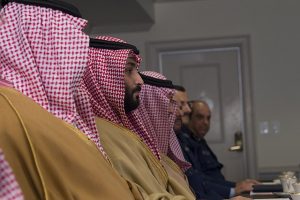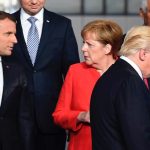by Derek Davison
In late March, when Saudi Arabia and its coalition allies began “Operation Decisive Storm,” the military effort to end Yemen’s ongoing civil war and restore President Abd Rabbuh al-Hadi to power there, they did so with American logistical assistance. In fact, according to The Washington Post, the early phases of the Saudi-led air campaign “relied heavily on U.S. surveillance images and targeting information,” and a US helicopter was responsible for rescuing two Saudi pilots when their plane crashed into the Gulf of Aden during a sortie on March 26. Last month, “Operation Decisive Storm” gave way to “Operation Restoring Hope,” which ostensibly meant an end to the heaviest parts of the air campaign. Aside from a brief humanitarian pause in the bombing earlier this month, however, there’s been no discernible change in the conduct of the campaign or in its intensity.
It’s hard to point to a single thing that the Saudi-led intervention has accomplished in pursuit of its declared goals. It hasn’t restored Hadi to power or tamped down the forces that ousted him, the Houthi-led Ansar Allah and allied forces loyal to former Yemeni President Ali Abdullah Saleh. True, just this week forces reportedly allied with President Hadi captured the city of Dhale, which is not far from the important Yemeni port city of Aden and is the base of operations for Yemen’s Saleh-aligned 33rd Armored Brigade. Between the city’s strategic location and the weapons the pro-Hadi forces seized in its capture, this was a significant victory. But it is literally the first gain of any importance by a pro-Hadi force in the two months since the Saudi campaign began.
In the meantime, the main effect of Saudi efforts has been to turn what was already a critical humanitarian situation into an outright “catastrophe.” Thanks to reckless conduct on both sides of the conflict, thousands of Yemeni civilians have been killed or wounded, and millions are either displaced or otherwise lack access to clean water, food, and healthcare. Speaking on Tuesday at a conference held by the Carnegie Endowment for International Peace in Beirut, European Council on Foreign Relations analyst Adam Baron called the war “unprecedented in Yemen in its level of destruction and its scope.” He added that “facts on the ground point to an extended conflict,” which means that most Yemenis have little to look forward to apart from further misery. It appears, actually, that the Saudi campaign has not weakened the Houthi position within Yemen in any significant way. On the contrary, according to Baron, Yemenis who had been ambivalent or even opposed to Ansar Allah’s takeover have, in the face of the bombing campaign, adopted the phrase “kullna Ansar Allah”—“we are all Ansar Allah.”
The one group in Yemen that has seen its fortunes improve under Decisive Storm and Restoring Hope has been al-Qaeda in the Arabian Peninsula (AQAP), which of all the regional affiliates of al-Qaeda U.S. officials consider “by far the most dangerous to the West because it has both technical skills and global reach.” In the chaos created by the civil war and the Saudi intervention, AQAP has been able to take control of the important seaport of Al-Mukalla—one of AQAP’s top commanders, Nasser al-Ansi, was killed in a drone strike on Al-Mukalla in early May—as well as a nearby airfield and oil terminal. Of potentially greater concern is that AQAP has made inroads into eastern Yemeni tribes that have opposed Ansar Allah’s takeover. Because the Saudi coalition has focused all of its attention on Ansar Allah, AQAP has been able to strengthen these ties without fear of pushback. As Baron put it, at this point “al-Qaeda and extremist groups in Yemen are stronger than they’ve ever been in their history.”
The Saudis and their coalition partners have justified their military intervention into Yemen on the basis of constraining Iran’s regional ambitions. But although there is a growing relationship between Ansar Allah and Tehran, the argument that the Houthis are nothing more than Iranian proxy agents has always rested on shaky ground. F\or example, Iranian officials actually tried to talk the Houthis out of seizing power in Yemen last year, before they took control of Yemen’s capital city of Sanaa. Moreover, despite concerns that Iranian arms shipments have enabled much of the Houthis’ military success, the Houthis’ weaponry has more likely come from Yemeni army units loyal to former President Saleh, and therefore, ultimately, from…the United States, which supplied them to Yemen in the first place. Ultimately, as Yemen scholar Gabriele vom Bruck recently wrote for LobeLog, the Saudi intervention probably has more to do with a desire to dominate Yemen politically and ideologically, a desire that the Houthi takeover has threatened to thwart, than it does with any fear of nefarious Iranian influence.
All this raises a critical question for the United States: is it really going to continue to involve itself in a campaign whose effects have uniformly run counter both to the interests of Yemeni civilians and to America’s own national security needs?
Despite the Obama administration’s insistence that it is simply providing “enabling support” to an intervention intended to force a political settlement to Yemen’s civil war, its support has been vital to the course of an air campaign that has, if anything, made a political solution more, not less, difficult to achieve. In fact, in early April Washington announced that it would begin “expediting” arms shipments to the Saudis, escalating America’s involvement from simply supplying targets to supplying both the targets and the ordinance used to strike them. America is thus providing critical logistical support to an operation that has only added to Yemen’s instability and that has worked largely to the benefit of America’s biggest security concern on the Arabian Peninsula.
Yet so far, America’s decision to enable the intervention has backfired in every imaginable way. Yemen is even less stable, Yemenis are suffering more, and AQAP’s position is stronger now than before the intervention began. Additionally, the escalating violence has stranded dozens of US citizens in Yemen, several of whom the Houthis are now reportedly holding captive. Washington contends that the situation is too dangerous to attempt an evacuation.
The Obama administration undoubtedly sees support for Saudi Arabia’s intervention as a relatively easy way to reassure Riyadh that the US is still a reliable ally despite its ongoing nuclear negotiations with Iran. But at some point, the value of reassuring the Saudis has to be weighed against the damage that their actions in Yemen have wrought on America’s regional and national interests.
Photo: Abdul-Malik al-Houthi, leader of Ansar Allah






America’s regional and national interests are the short-sighted support of imperialist Israel and Saudi Arabia, and “R2P” (remember that in Libya?) is a no-show. So kill ’em, women and children first.
This piece is a fine description of the situation. I would add two facts:
1. The Saudis are using the US cluster bombs which the US often uses. The Convention on Cluster Munitions, banning them, has been ratified by 92 states, not including the US.
2. The Saudi offensive has been entirely air attacks. A recent piece on LL featured an amusing (but erroneous) photo of ground troops in goggles, which we were unable to comment on. Apparently the Saudi despots have no ground offensive military capability. They called on Pakistan to do it but Islamabad declined the offer. The US has adopted a new policy against (unsuccessfully) invading other countries, which I expect is temporary.
When will Obama starts to use sticks instead of carrots with the dangerous spoiled kids of the Saudi regime and their GCC poodles? After the USA-Iran deal or when nothing will be left of Yemen and Syria except Al Qaeda?